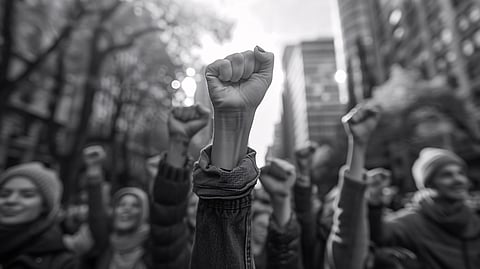
- Home
- NG Hindi
- India
- World
- Politics
- Sex & Relationships
- Entertainment
- Culture
- Lifestyle
- Economy
- Sports
- Sp. Coverage
- Misc.
- NewsGram Exclusive
- Jobs / Internships

This story by Mamisoa Raveloaritiana originally appeared on Global Voices on 7 October 2025
For years, Madagascar has faced repeated social crises, primarily due to frequent power outages and water supply cuts in homes lasting hours, if not days. These circumstances have been a source of frustration, sparking fresh protests in the country in September 2025.
Most people usually remain quiet about these cuts, primarily out of fear of arrest or reprisal from the government. However, infuriated young people, part of Generation Z, called for protests through the spontaneous movement “Leo Délestage” (Fed Up With Electricity Cut-Offs).
The call for peaceful demonstrations was shared widely on social media, attracting thousands of people to protest peacefully against the daily outages in Antananarivo, the capital of Madagascar, and several other regions, and reclaim their fundamental right to water and electricity. The situation took a violent turn with disorderly behavior and late-night unrest, leaving several injured and at least five dead, including two children.
In Madagascar, the state-owned company Jirama is responsible for producing and distributing electricity and drinking water to the country's 30 million residents. However, fluctuating water levels during the dry season, dilapidated facilities, and hydraulic dams that do not provide enough water are leaving citizens thirsty and without regular utility access.
In Antananarivo, some districts experience several hours of power outages, and many residents don’t receive any or very little running water. Tankers and emergency tankers fall short, and well water, which is often untreated, becomes the only option available.
Due to a lack of water, residents line up with their containers in front of public pumps, which only provide a trickle of water and open at set times. Also, the water is subject to a fee: MGA 2,000 (about USD 0.50) for 20 litres.
On September 25, 2025, the authorities banned the protest scheduled to take place in Ambohijatovo public park in Antananarivo, but protesters defied these restrictions. Although demonstrations remained peaceful, the authorities fired tear gas and deployed an extensive security force presence, making several arrests. Witnesses report cases of physical violence against the protesters, including online influencers.
This TV5 Monde video shows tear gas being fired when protesters attempted to enter Ambohijatovo stadium to protest:
The signs that protesters held up read messages such as: “Let us express our rights,” “People are fed up with power outages,” and “We don’t want trouble, just recognition of our rights.”
At nightfall on September 25, looting broke out in several districts of Antananarivo. In response, the Analamanga region Police Chief, Angelo Ravelonarivo, announced a dusk-to-dawn curfew from 7 pm to 5 am, to remain in force until calm was restored.
Despite this restriction, acts of vandalism continued throughout the night. Looters targeted supermarkets, shopping malls, and banks, taking advantage of the complete absence of law enforcement to loot everything they could. Fires were started in various places, sparking great concern among residents.
Internet users shared their feelings, various images, and pleas for help online. These posts simultaneously reflect their outrage, fatigue, and hopes for youth-led change within the country.
This video of a woman, reportedly named Alissa, who is the mother of a three-month-old baby, crossing the police roadblock on her quad bike has circulated widely on social networks, especially Facebook.
Although people praised her boldness, calling her a courageous woman, she was soon arrested. Fitiavana Mickael, a Malagasy influencer who police arrested and released the following day, called for this woman’s release.
Although people praised her boldness, calling her a courageous woman, she was soon arrested. Fitiavana Mickael, a Malagasy influencer who police arrested and released the following day, called for this woman’s release.
Following this appeal and that of other internet users, she was released.
On Facebook, Ohappydeal.mg, one of the vandalized businesses, expressed its sadness over these events:
Many professionals have spoken out, expressing their solidarity, outrage, and even calling for tangible solutions to this crisis. On LinkedIn, Malagasy citizen Lalaina Minah Ranaivomanana posted:
Also on LinkedIn, Santatra Rakotovao shared how the power outages affect her freelance work, appealing to human rights defenders and international legal experts to monitor the situation closely:
On September 26, 2025, the protesters continued their march throughout the provinces. In the Antsiranana ou Diego Suarez Province, northern Madagascar, a university student was shot and killed by police. A video of the attack was captured by Fit Prod-Action and was later aired by the TV and radio station KOLO TV. Students from the University of Antsiranana marched towards the town center with the body of their classmate.
On September 27, the situation took another turn when President Andry Rajoelina dismissed Energy Minister, Olivier Jean Baptiste. Although this decision was presented as a solution to appease public anger, it wasn’t enough to calm the tensions on the streets. Protesters believe the problem far exceeds a simple change of minister and have continued their efforts.
